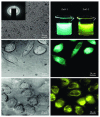The Advancing of Zinc Oxide Nanoparticles for Biomedical Applications
- PMID: 30073019
- PMCID: PMC6057429
- DOI: 10.1155/2018/1062562
The Advancing of Zinc Oxide Nanoparticles for Biomedical Applications
Abstract
Zinc oxide nanoparticles (ZnO NPs) are used in an increasing number of industrial products such as rubber, paint, coating, and cosmetics. In the past two decades, ZnO NPs have become one of the most popular metal oxide nanoparticles in biological applications due to their excellent biocompatibility, economic, and low toxicity. ZnO NPs have emerged a promising potential in biomedicine, especially in the fields of anticancer and antibacterial fields, which are involved with their potent ability to trigger excess reactive oxygen species (ROS) production, release zinc ions, and induce cell apoptosis. In addition, zinc is well known to keep the structural integrity of insulin. So, ZnO NPs also have been effectively developed for antidiabetic treatment. Moreover, ZnO NPs show excellent luminescent properties and have turned them into one of the main candidates for bioimaging. Here, we summarize the synthesis and recent advances of ZnO NPs in the biomedical fields, which will be helpful for facilitating their future research progress and focusing on biomedical fields.
Figures



References
-
- Sahoo S., Maiti M., Ganguly A., George J. J., Bhowmick A. K. Effect of zinc oxide nanoparticles as cure activator on the properties of natural rubber and nitrile rubber. Journal of Applied Polymer Science. 2007;105(4):2407–2415. doi: 10.1002/app.26296. - DOI
Publication types
LinkOut - more resources
Full Text Sources
Other Literature Sources
Miscellaneous

